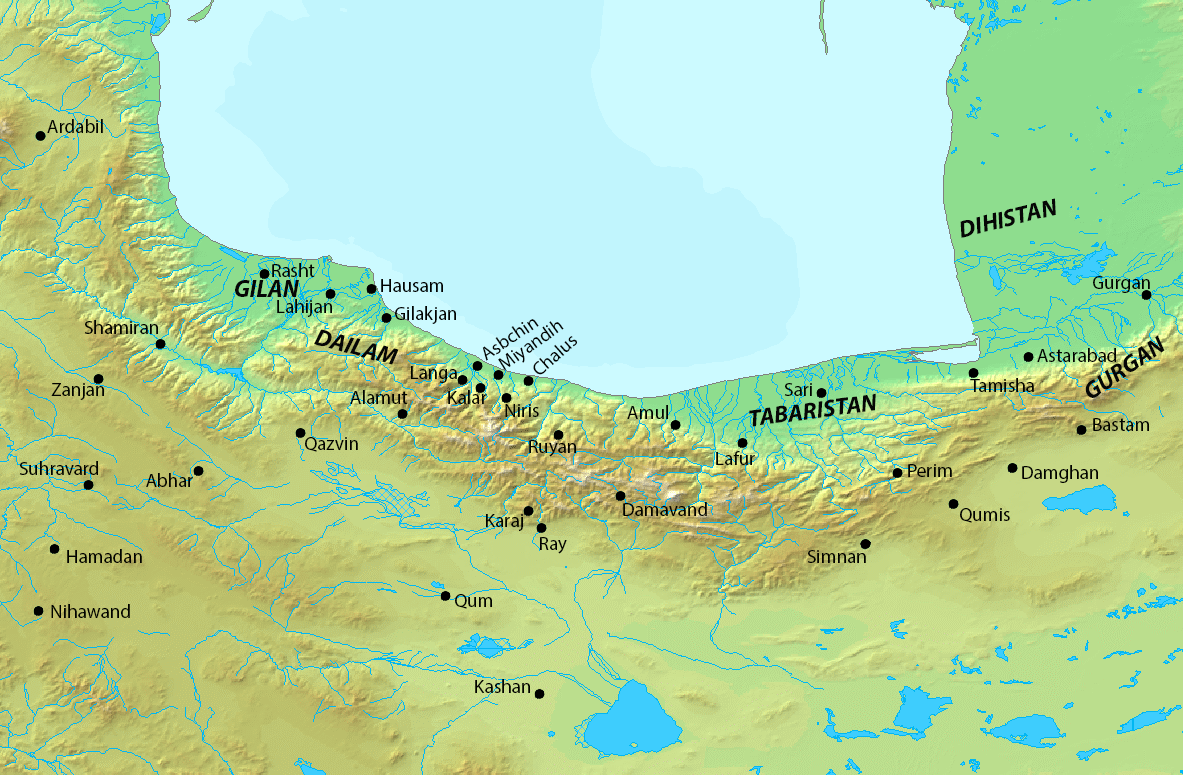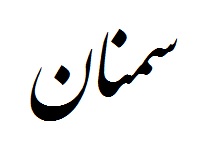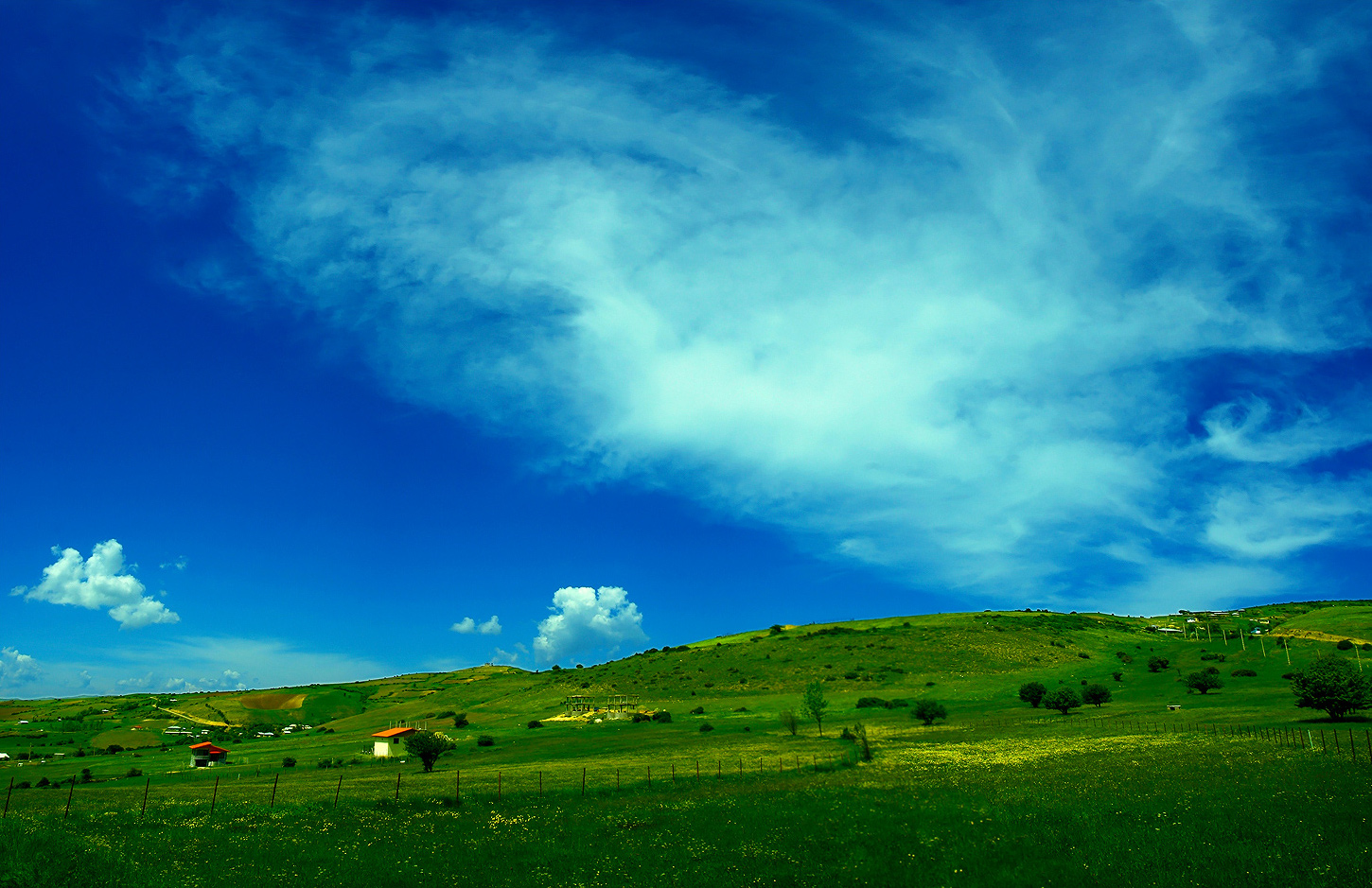|
Al-Hasan Ibn Al-Fairuzan
Al-Hasan ibn al-Fairuzan () (fl. 10th century) was a Daylamite prince from the Firuzanid family. Biography Al-Hasan was the son of Fairuzan, a Daylamite soldier who, along with his brother Kaki, served the Alid dynasties of northern Iran.Nazim (1987), p. 164 In 902, both of them were killed during a Samanid invasion of Tabaristan. Kaki had a son named Makan ibn Kaki, who together with al-Hasan served the Alids. Makan had established family ties through marriage with the Alids, as Ja'far, the son of imam Hasan ibn Ali al-Utrush (r. 914–917), was his son-in-law. The latter was engaged in a complex struggle against al-Utrush's designated successor Abu Muhammad Hasan ibn Qasim, known as the '' Da'i ila'l-Haqq'' (r. 917–928), and it was not until 923 that Ja'far and his brother Ahmad succeeded in ousting the ''Da'i'' and forcing him to exile. When Ja'far died in 924, he left the throne to Ahmad's son Abu Ali Muhammad, but al-Hasan and Makan deposed Muhammad and installed ... [...More Info...] [...Related Items...] OR: [Wikipedia] [Google] [Baidu] |
Semnan (city)
Semnan (; ) is a city in the Central District (Semnan County), Central District of Semnan County, Semnan province, Semnan province, Iran, serving as capital of the province, the county and the district. The city is on the alluvial fan of the Golrudbar creek in the north-central part of the country, 216 km east of Tehran and 640 km west of Mashhad. With a population of 185,129 people in 2016, Semnan is the hub of the Semnani languages, Semnani language, a sub-branch of the Iranian languages spoken to the north. It is home to the Semnani people, Semnani ethnic group. Semnan offers various recreational activities; historical and religious sites; festivals, gardens and parks; and centers of higher education and Semnani culture. The city is the cultural and political capital of Semnan province. The city's main souvenirs are Narcissus (plant), daffodil flowers, Sheermal, Shirmal pastry, Kolüçe cookies, kilim rugs, and shortbread. Etymology There are several theories w ... [...More Info...] [...Related Items...] OR: [Wikipedia] [Google] [Baidu] |
Samanid
The Samanid Empire () was a Persianate society, Persianate Sunni Islam, Sunni Muslim empire, ruled by a dynasty of Iranian peoples, Iranian ''dehqan'' origin. The empire was centred in Greater Khorasan, Khorasan and Transoxiana, at its greatest extent encompassing northeastern Iran and Central Asia, from 819 to 999. Four brothers—Nuh ibn Asad, Nuh, Ahmad ibn Asad, Ahmad, Yahya ibn Asad, Yahya, and Ilyas ibn Asad, Ilyas—founded the Samanid state. Each of them ruled territories under Abbasid Caliphate, Abbasid suzerainty. In 892, Ismail Samani (892–907) united the Samanid state under one ruler, thus effectively putting an end to the feudal system used by the Samanids. It was also under him that the Samanids became independent of Abbasid Caliphate, Abbasid authority. However, by 945, the government was under the de facto control of the Turkic military slave faction, and the Samanid family's authority had become purely symbolic. The Samanid Empire is part of the Iranian Interm ... [...More Info...] [...Related Items...] OR: [Wikipedia] [Google] [Baidu] |
Daylam
Daylam (), also known in the plural form Daylaman () (and variants such as Dailam, Deylam, and Deilam), was the name of a mountainous region of inland Gilan, Iran. It was so named for its inhabitants, known as the Daylamites. The Church of the East established a Dioceses of the Church of the East to 1318, metropolitan diocese for Daylam and Gilan around 790 under Shubhalishoʿ., p. 166. See also *Buyid dynasty *Daylami language *Talysh people *Al-Daylami (other), al-Daylami *Zaydiyyah *Nizari Ismaili state References Bibliography * Historical regions of Iran History of Gilan {{Iran-geo-stub ... [...More Info...] [...Related Items...] OR: [Wikipedia] [Google] [Baidu] |
Amol
Amol ( ; ) is a city in the Central District (Amol County), Central District of Amol County, Mazandaran province, Mazandaran province, Iran, serving as capital of both the county and the district. Amol is located on the Haraz River bank. It is situated less than south of the Caspian Sea and less than north of the Alborz mountains. It is northeast of Tehran, and west of the provincial capital, Sari, Iran, Sari. It is one of the oldest cities in Iran, and a historic city, with its foundation dating back to the Amardi tribe, who inhabited the region in the Iron Age. Amol is the center of industry and culture of Mazandaran, the rice capital of Iran, and one of the most important cities of the transportation, agriculture, and tourism industries in Iran. It is known as the ''History, Science and Philosophy city'', ''City that does not die'' and ''Hezar Sangar city''. History Pre-Islamic era According to the city government, the name is derived from ''Amardi'', a tribe mentioned ... [...More Info...] [...Related Items...] OR: [Wikipedia] [Google] [Baidu] |
Gurgan
Gorgan (; ) is a city in the Central District of Gorgan County, Golestan province, Iran, serving as capital of the province, the county, and the district. It lies approximately to the northeast of the national capital Tehran, and some away from the Caspian Sea. History There are several archaeological sites near Gorgan, including Tureng Tepe and Shah Tepe, in which remains dating from the Neolithic and Chalcolithic eras. Some other important Neolithic sites in the area are Yarim Tepe, and Sange Chaxmaq. The nearby Shahroud Plain has many such sites. More than 50 are on the Gorgan Plain. According to the Greek historian Arrian, Zadracarta was the largest city of Hyrcania and the site of the "royal palace". The term means "the yellow city", and it was given to it from the great number of oranges, lemons, and other fruit trees which grew in the outskirts of that city. Hyrcania became part of the Achaemenid Empire during the reign of Cyrus the Great (559–530 BC), ... [...More Info...] [...Related Items...] OR: [Wikipedia] [Google] [Baidu] |
Asfar Ibn Shiruya
Asfar ibn Shiruya ( Gilaki/: died 931) was an Iranian military leader of Gilaki origin, active in northern Iran (esp. Tabaristan and Jibal) in the early 10th century. He played a major role in the succession disputes of the Alids of Tabaristan, and managed to establish himself as the ruler of Tabaristan and northern Jibal briefly from 928 to 930. Name ''Asfār'' is a local Caspian form of Middle Persian ''aswār'', which means "rider, cavalryman". The New Persian form of the word is ''savār''. Biography Background and early life A native of Lahijan, Asfar belonged to the Gilaki clan of Varudavand, and was the son of a certain Shiruya (Sheroe). Asfar had a brother named Shirzad, and grew up in an environment where "Iranian culture, memories of the glories of the Iranian Empire, were alive among them." Like many other Gilakis and Daylamites, Asfar was not a Muslim—he was in fact a nationalist, who loathed Arab rule and admired the Iranian Empire. According to the 10th-centur ... [...More Info...] [...Related Items...] OR: [Wikipedia] [Google] [Baidu] |
Gilaks
Gilaks ( Gilaki: گيلٚکؤن, ) are an Iranian peoples native to south of Caspian sea. They form one of the main ethnic groups residing in the northern parts of Iran. Gilak people, along with the closely related Mazandarani people, comprise part of the Caspian people, who inhabit the southern and southwestern coastal regions of the Caspian Sea. They speak the Gilaki language, an Iranian language that is closely related to Mazandarani. History The mountainous regions of northern Iran on the southwest coast of the Caspian Sea, now comprising the southeastern half of Gilan Province, was also referred to as Daylam. The inhabitants of the region were called the Daylamites. Gilan was the place of origin of the Ziyarid dynasty and Buyid dynasty in the mid-10th century. The rule of the Daylamites were put to and end by the Turkish invasions of the 10th and 11th centuries CE, which saw the rise of Ghaznavid and Seljuk dynasties. From the 11th century CE to the rise of ... [...More Info...] [...Related Items...] OR: [Wikipedia] [Google] [Baidu] |
Ismail Ibn Ja'far Ibn Al-Nasir
In the biblical Book of Genesis, Ishmael (; ; ; ) is the first son of Abraham. His mother was Hagar, the handmaiden of Abraham's wife Sarah. He died at the age of 137. Traditionally, he is seen as the ancestor of the Arabs. Within Islam, Ishmael is regarded as a prophet and the ancestor of the Ishmaelites (Hagarenes or Adnanites) and patriarch of Qaydār. Etymology The name "Yishma'el" existed in various ancient Semitic cultures, including early Babylonian and Minæan. In the Amorite language, it is attested as ''yaśmaʿ-ʾel''. It is a theophoric name translated literally as "God (El) has hearkened", suggesting that "a child so named was regarded as the fulfillment of a divine promise". Genesis narrative The Genesis narrative sees the account of Ishmael's life through the . Birth The birth of Ishmael was planned by the Patriarch Abraham's first wife, who at that time was known as Sarai. She and her husband Abram (Abraham) sought a way to have children in order to fulfil ... [...More Info...] [...Related Items...] OR: [Wikipedia] [Google] [Baidu] |
Muhammad Ibn Ahmad Ibn Al-Nasir
Muhammad (8 June 632 CE) was an Arab religious and political leader and the founder of Islam. Muhammad in Islam, According to Islam, he was a prophet who was divinely inspired to preach and confirm the tawhid, monotheistic teachings of Adam in Islam, Adam, Noah in Islam, Noah, Abraham in Islam, Abraham, Moses in Islam, Moses, Jesus in Islam, Jesus, and other Prophets and messengers in Islam, prophets. He is believed to be the Seal of the Prophets in Islam, and along with the Quran, his teachings and Sunnah, normative examples form the basis for Islamic religious belief. Muhammad was born in Mecca to the aristocratic Banu Hashim clan of the Quraysh. He was the son of Abdullah ibn Abd al-Muttalib and Amina bint Wahb. His father, Abdullah, the son of tribal leader Abd al-Muttalib ibn Hashim, died around the time Muhammad was born. His mother Amina died when he was six, leaving Muhammad an orphan. He was raised under the care of his grandfather, Abd al-Muttalib, and paternal ... [...More Info...] [...Related Items...] OR: [Wikipedia] [Google] [Baidu] |
Ahmad Ibn Al-Nasir
Ahmad () is an Arabic male given name common in most parts of the Muslim world. Other English spellings of the name include Ahmed. It is also used as a surname. Etymology The word derives from the root ( ḥ-m-d), from the Arabic (), from the verb (''ḥameda'', "to thank or to praise"), non-past participle (). Lexicology As an Arabic name, it has its origins in a Quranic prophecy attributed to Jesus in the Quran which most Islamic scholars concede is about Muhammad. It also shares the same roots as Mahmud, Muhammad, Hamed, and Hamad. In its transliteration, the name has one of the highest number of spelling variations in the world. Some Islamic traditions view the name Ahmad as another given name of Muhammad at birth by his mother, considered by Muslims to be the more esoteric name of Muhammad and central to understanding his nature. Over the centuries, some Islamic scholars have suggested the name's parallel is in the word 'Paraclete' from the Biblical text,"Isa", ... [...More Info...] [...Related Items...] OR: [Wikipedia] [Google] [Baidu] |
Da'i
A da'i (, ) is generally someone who engages in Dawah, the act of inviting people to Islam. See also * Dawah * Da'i al-Mutlaq, 'the absolute (unrestricted) missionary' * Hujja * List of converts to Islam The following is a list of notable people who converted to Islam from a different religion or no religion ''(who have individual Wikipedia articles)''. This article addresses only past professions of faith by the individuals listed, and is ... References {{Reflist Arabic words and phrases Ismaili da'is Islamic terminology Religious titles ... [...More Info...] [...Related Items...] OR: [Wikipedia] [Google] [Baidu] |
Abu Muhammad Hasan Ibn Qasim
Abu or ABU may refer to: Aviation * Airman Battle Uniform, a utility uniform of the United States Air Force * IATA airport code for A. A. Bere Tallo Airport in Atambua, Province of East Nusa Tenggara, Indonesia People * Abu (Arabic term), a kunya when written in the construct state * Ab (Semitic), a common part of Arabic-derived names, meaning "father of" in Arabic * Abu al-Faraj (other) * Abu Baker Asvat, a murdered South African activist and medical doctor * Abu Ibrahim (other) * Abu Mohammed (other) * Abu Salim (other) *Abdul-Malik Abu (born 1995), American basketball player in the Israeli Premier Basketball League * Raneo Abu, Filipino politician Places * Abu (volcano), a volcano on the island of Honshū in Japan * Abu, Yamaguchi, a town in Japan * Ahmadu Bello University, a university located in Zaria, Nigeria * Atlantic Baptist University, a Christian university located in Moncton, New Brunswick, Canada * Elephantine, Egypt, known as Abu ... [...More Info...] [...Related Items...] OR: [Wikipedia] [Google] [Baidu] |







